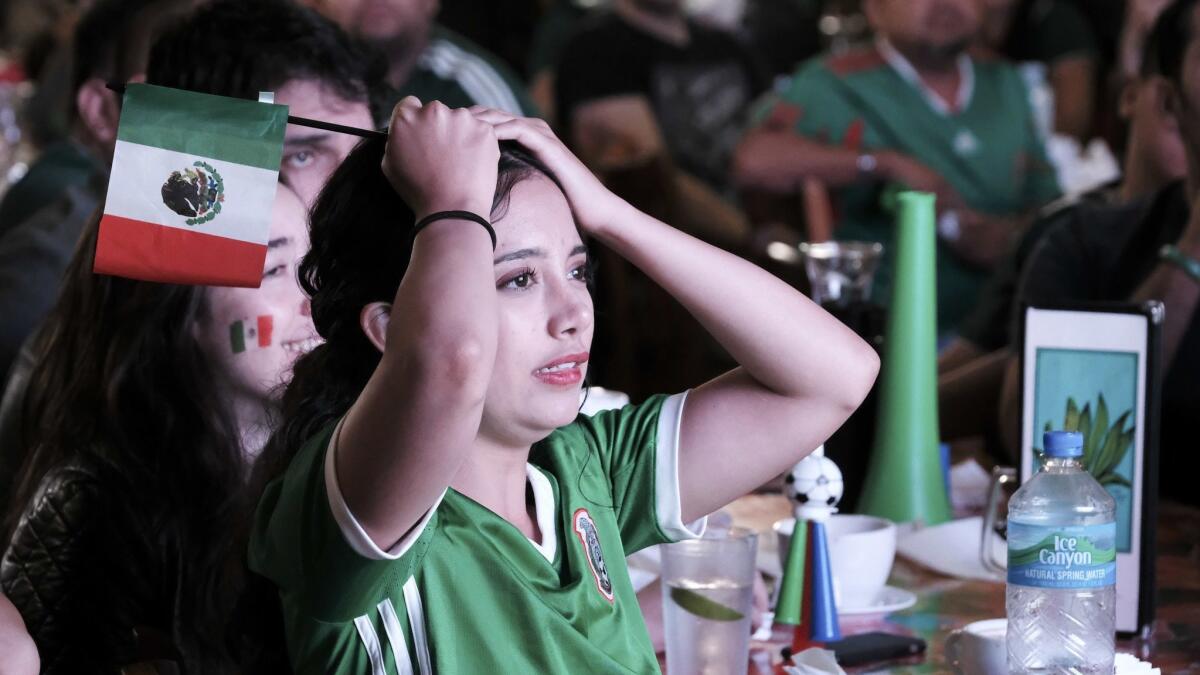Ratings are down, but Telemundo and Fox are making the best of a U.S.-free World Cup

In a Volkswagen commercial running during TV coverage of the World Cup, soccer fans from countries around the globe are seen inviting U.S. fans to start rooting for their teams.
It’s a tough reminder of the blow dealt to Fox and Telemundo when the U.S. team failed to qualify for the tournament, a major factor in the drop-off of the 2018 FIFA World Cup TV audience when compared with 2014.
Through the round of 16, Fox has averaged 3.64 million viewers, down 36% from what ESPN and ABC averaged in 2014, according to Nielsen. Excluding the U.S. matches in 2014, the drop is 19%. Telemundo’s average audience through July 1 is 2.1 million viewers, which includes streaming. Univision averaged 3.5 million viewers over the entire tournament in 2014.
But while the comparisons to Brazil four years ago aren’t pretty, the networks carrying this year’s tournament say they are doing better than expected, considering the circumstances. Not only is there no U.S. team, but the Russian venue meant many early-round games started in the morning in the U.S. In 2014, they aired in the afternoon and prime time.
Despite the obstacles, Telemundo Deportes President Ray Warren said the Comcast-owned Spanish-language network is delivering the audience levels promised to advertisers who bought commercial time in the tournament. Four matches with Mexico’s team, a major attraction for Telemundo’s viewers, have been a significant help.
“We planned and budgeted to have Mexico in four games,” Warren said. “It was a gift from the Lord.”
Mexico has accounted for the top two most-watched matches of the tournament on Telemundo.
The June 23 match with South Korea averaged 7.1 million viewers. The Mexico-Germany match on June 17 pulled 7.42 million viewers. The totals include online streaming of the telecasts, which have added as much as 800,000 to the Telemundo audience totals.
Telemundo expects to take in $250 million in ad sales for the tournament. Four years ago, Univision took in $177 million, according to data from Standard Media Index. Fox hasn’t released its projection, but in 2014, the combined take of Walt Disney Co.’s ESPN and ABC was $112 million.
Fox paid $400 million, and Telemundo forked over $600 million for the rights to carry the World Cup in 2018 and 2022, and the women’s World Cup in 2019 and 2023 — doubling what Disney and Univision previously paid. Fox and Telemundo also paid nearly $1 billion combined for the rights to the 2026 tournament.
Fox executives fully expected the ratings drop-off from 2014 — they reportedly trimmed their ratings and ad sales projections after the U.S. failed to qualify. (The network also scaled back its costs, having some announcers call games remotely from a Los Angeles studio.)
But going into the quarterfinals Friday, Fox executives are hoping the excitement of the matches played so far will help the network finish strong by drawing some of the casual fans who might not have tuned in yet to any World Cup action.
“The good news is that as we’ve gone deeper into the tournament, those early-morning windows that we had in the first round have gone away and that’s less of a challenge,” said Mike Mulvihill, executive vice president of research, league operations and strategy for Fox Sports. “You also feel the absence of the U.S a little bit less” in the ratings.
The network already is seeing an improvement.
Fox hit an audience high on Sunday with Croatia’s win over Denmark, watched by 5.9 million viewers. On July 3, the audience for Fox’s World Cup telecasts of Brazil’s win over Mexico and Belgium’s comeback win over Japan were higher than comparable tournament days in 2010 and 2014. Telemundo also has seen its viewership rise as the tournament has progressed.
The U.S. team, which failed to qualify for the first time since 1986, rarely plays more than three games during the tournament. But the audiences for those contests tower over non-U.S. competition. In 2014, an early-stage match between the U.S. and Portugal pulled a record 18.2 million viewers on ESPN and 6.5 million viewers on Univision.
“There is only so much you can do,” said Lee Berke, a sports media consultant. “It’s the U.S. team that drives those ratings. Even if you’re an occasional fan, you’re going to watch the U.S. team with of a sense of nationalism, patriotism and pride.”
Berke said networks also have to think long term about the deals they made in 2011 before the venues were selected.
The time zones for U.S. audiences won’t be better in 2022, when the World Cup will be played in Qatar. The tournament also will be played during the winter that year, putting it in competition with the NFL season.
A major payoff potentially arrives in 2026, when the World Cup comes to North America. Not only will the contests be time-zone friendly for U.S. viewers, but the host nation’s team automatically qualifies.
Warren said this year’s tournament already is giving Telemundo momentum in its push to become the leading network for Spanish-speaking U.S. viewers after decades of being an also-ran to Univision.
“We paid a lot of money for the rights because we knew what it could do for Telemundo,” Warren said. “The real plan is to transfer hearts and minds of viewers in the Spanish-language space to Telemundo.”
Telemundo’s research finds that 71% of the Latino population describes itself as soccer fans; 62% of those fans say they would give up all other TV programming before giving up watching soccer.
Telemundo has used the large audience for the daytime games as a lead-in to special editions of its morning program, “Un Nuevo Dia.” It also has boosted Telemundo’s ratings in other time periods.
Fox sought the World Cup TV rights in part because it needed a major attraction for the launch of its cable channel Fox Sports 1. But the World Cup becomes even more valuable to Fox’s broadcast network going forward, as live sports will be the core of its programming after parent company 21st Century Fox completes the proposed sale of its production studio and entertainment cable assets.
One of Fox’s selling points to FIFA when it bid for the event was that it would put more World Cup games on free, over-the-air TV than any English-language network has offered before.
Networks have focused on capturing the growing number of viewers who watch video on their digital devices, which has reached record levels for both Telemundo and Fox during the tournament. But Mulvihill said the communal experience of fans watching World Cup matches on TV sets in bars, restaurants, hotels and offices can add between 20% and 30% to the audience total, and some advertisers are paying extra for those viewers.
“The out-of-home TV viewership is significantly bigger than what we’re getting from digital streaming, and we’re monetizing some of that,” Mulvihill said.
So far, Miami has been the strongest TV market for World Cup telecasts, with the combined networks averaging a 9.7 rating, according to Nielsen data. Los Angeles is second with a 6.5 rating, followed by New York (4.7), Washington, D.C. (4.6), San Francisco (4.3), Houston (4.2) and San Diego (4.0). A rating point is equal to the percentage of homes in the market that are tuned in.
Twitter: @SteveBattaglio
More to Read
Inside the business of entertainment
The Wide Shot brings you news, analysis and insights on everything from streaming wars to production — and what it all means for the future.
You may occasionally receive promotional content from the Los Angeles Times.











